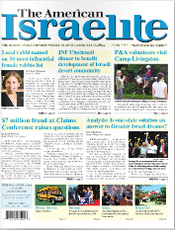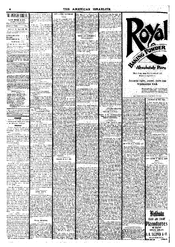- The American Israelite
-
The American Israelite
August 5, 2010, front pageType Weekly newspaper Format Broadsheet Publisher Netanel Deutsch Editor Netanel Deutsch Founded July 15, 1854 Headquarters 18 West Ninth Street
Cincinnati, OhioOfficial website www.americanisraelite.com The American Israelite is a Jewish weekly newspaper published in Cincinnati, Ohio. Founded in 1854 as The Israelite and assuming its present name in 1874, it is the longest-running English-language Jewish newspaper still published in the United States.[1]
The paper's founder, Rabbi Isaac Mayer Wise, and publisher, Edward Bloch and his Bloch Publishing Company, were both heavily influential figures in American Jewish life. During the 19th century, The American Israelite became the leading organ for Reform Judaism in America. During the early 20th century it helped geographically dispersed American Jews, especially in the West and the South of the country, keep in touch with Jewish affairs and their religious identity.
Contents
Founding and early history
The first Jewish newspaper published in Cincinnati was the English-language The Israelite, established on July 15, 1854.[2] It was also among the first Jewish publications in the nation.[3] It was founded by Rabbi Isaac Mayer Wise, who became known as the father of Reform Judaism in America.[4] Its initial issues were published by Charles F. Schmidt.[5] The paper lost $600 in its first year, and although Wise repaid the publisher out of his own funds, Schmidt terminated the relationship.[5] The Israelite began to be published by Edward Bloch and his Bloch Publishing Company with the issue of July 27, 1855.[5] Bloch, who was Wise's brother-in-law, subsequently became known as the dean of American Jewish publishers.
The newspaper's motto was from the start, and still is, יהי אור "Let There Be Light".[6][2] Its two goals were to propagate the principles of Reform Judaism and to keep American Jews, who often lived in small towns singly or in communities of two or three families, in touch with Jewish affairs and their religious identity.[7]
The publication, along with a German-language supplement that Wise started the following year, Die Deborah, soon attracted a large circulation and was influential in helping the nascent Reform Judaism movement spread throughout North America.[8] Both Wise and the paper had a reach beyond Cincinnati, and especially to the growing Jewish communities in the American Midwest and South.[1] In 1858, for instance, the members of Congregation B'nai Israel in Memphis, Tennessee advertised for their first rabbi in The Israelite, at the same time they advertised for a kosher butcher.[4]
Despite its spread, the early years of The Israelite were a financial struggle. Most subscribers did not pay their bills, the Panic of 1857 adversely affected it, and the paper lost half its subscribers in the South during the Civil War.[5] Bloch travelled east several times in the late 1850s in order to solicit subscriptions and advertising.[5] Wise's admitted sloppiness in monetary matters did not help either.[5] Nevertheless, the newspaper and Bloch stayed out of bankruptcy and relocated to larger offices twice during this period.[5]
Wise, a prolific writer, published in the editorial columns of The Israelite numerous studies on various subjects of Jewish interest. Besides being the leading organ for American Reform Judaism, it also forcefully defended the civil and religious rights of all Jews.[9] Wise tirelessly expounded his call to the "ministers and other Israelites" of the United States, urging them to form a union which might put an end to the prevalent religious anarchy.[10] In 1873, twenty-five years after he had first broached the idea, the Union of American Hebrew Congregations was organized at Cincinnati.[10] Another campaign he presented in the columns of The Israelite was the desire for an educational institution, and this eventually led to success in 1875 when the Hebrew Union College opened its doors for the reception of students.[10] Wise also wrote a number of novels, which appeared first as serials in the Israelite.
A new name and continued influence
The Israelite was renamed The American Israelite beginning with the issue of July 3, 1874.[5] The goal was to make the name more in consonance with the ideas it represented.[7] Despite the change, the paper continued to cover and advocate for not only American Jews but also Jews around the world.[6] By 1879, a typical issue had eight pages 28-by-42-inch in size, and a subscription cost $4, or $5 if the Die Deborah four-page supplement was included.[11]
Rabbi Wise's son Leo Wise, who had become business manager for the paper in 1875,[7] took over as its publisher from 1883 to 1884, and then he did so again, permanently, in 1888 (due apparently to some kind of rupture between Leo Wise and Bloch).[5] A sister publication, The Chicago Israelite, was started in 1885.[5] The papers stressed their reputation in trade publications, stating "None but clean advertisements of reputable houses accepted."[12]
Leo Wise gradually took over the principle editorial functions from his father,[7] but Rabbi Wise remained active on the paper until his death on March 26, 1900,[6][8] writing an editorial for it just a few days before.[9] Ownership then passed to Leo Wise.[13]
By 1900, The American Israelite, in combination with The Chicago Israelite, claimed a circulation of other 35,000, about 12,000 in Ohio and Illinois and the balance spread across almost every other state as well as Canada and Mexico.[12] The publication Printer's Ink said they had the largest guaranteed circulation of any Jewish newspaper in the U.S.,[12] and it continued to be especially strong in the West and the South.[7] One 1902 book characterized The American Israelite as "the leading Jewish newspaper in the United States and the National Journal of the Jews."[14]
In the early 20th century, the paper's short articles were sometimes picked up and run by The New York Times with a credit "From The American Israelite".[15][16][17] In those years, The American Israelite became known for its very strong stance against the new Zionism movement, calling it in 1902 a "pernicious agitation" that would undermine the acceptance of Jews in the countries where they current resided.[15] Rabbi David Philipson was among the editorial contributors to the paper[7] who used it to oppose Zionism, arguing that Judaism was a religion exclusively, and thus stateless. Other noted contributors to the paper in this era included Rabbi Moses Mielziner and Jewish history scholar Gotthard Deutsch, as well as other prominent rabbis and Jewish thinkers within the country. The paper gave extensive coverage to the goings-on of the Union of American Hebrew Congregations and the Hebrew Union College (and was sometimes viewed as a publication of them), as well as notices of various rabbinical conferences.[7]
Die Deborah was discontinued after Isaac Wise's death, then resumed for a while.[7] The Chicago Israelite ceased publication in 1920.[18] Leo Wise edited The American Israelite until his retirement at age 78 in 1928[19] (he died in 1933).[13] Another son of Isaac, Isidor Wise, worked as a writer and associate editor for the paper until his death in 1929.[20]
Subsequent history
Leo Wise was succeeded as editor and publisher of The American Israelite in 1928 by his half-brother, Rabbi Jonah Wise of New York, who remained in that city[19] and who himself became a long-time leader of American Reform Judaism.
The Jonah Wise arrangement did not last long, and in 1930, journalist Henry C. Segal bought the paper and became its editor and publisher for more than five decades, until his death in 1985.[21] Along with Isaac Wise, Segal is still named on the paper's masthead.[2] Contributors to the newspaper in this era included writer Donald Swerdlow (later Don Canaan).
By the 1990s, the paper was focusing on local Jewish news.[22] In 1995, The American Israelite was sued for $2 million by an Ohio lawyer for calling him and his son anti-Semitic.[23][22]
By 2010, Ted Deutsch was the editor and publisher. A typical issue ran 24 pages, with color front and back pages and black-and-white inside.[24] Some stories were locally written, while many others were run from the Jewish Telegraphic Agency.[24] It published full facsimile copies of its issues on its website.[24]
See also
References
- ^ a b Irwin, Julie (March 2000). "Wise Man". Cincinnati Magazine. http://books.google.com/books?id=2-0CAAAAMBAJ&pg=PA30.
- ^ a b c "American Israelite: Current Issue". The American Israelite. http://www.americanisraelite.com/. Retrieved August 5, 2010.
- ^ "Charles E. Bloch, Long a Publisher". The New York Times: p. 17. September 3, 1940. http://select.nytimes.com/mem/archive/pdf?res=FB0713F7385A11728DDDAA0894D1405B8088F1D3.
- ^ a b "History of Temple Israel". Encyclopedia of Southern Jewish Communities. Jackson, Mississippi: Goldring / Woldenberg Institute of Southern Jewish Life. 2006. http://www.isjl.org/history/archive/tn/HistoryofTempleIsrael.htm. Retrieved July 22, 2010.
- ^ a b c d e f g h i j Singerman, Robert (1994). "Bloch & Company: Pioneer Jewish Publishing House in the West". In Kabakoff, Jacob. Jewish Book Annual, Volume 52, 1994–1995. New York: Jewish Book Council. pp. 110–130. ISBN 1885838026. http://www.blochpub.com/early_history.
- ^ a b c May, Max B. (April 3, 1898). "Isaac M. Wise". The New York Times Magazine: p. SM11. http://query.nytimes.com/mem/archive-free/pdf?_r=1&res=9904EFDF1139E433A25750C0A9629C94699ED7CF.
- ^ a b c d e f g h Wise, Leo (1901–1906). "American Israelite, The". Jewish Encyclopedia. Funk and Wagnalls. http://www.jewishencyclopedia.com/view.jsp?letter=A&artid=1388.
- ^ a b "Career of Rabbi Wise.". The New York Times: p. 1. March 27, 1900. http://query.nytimes.com/mem/archive-free/pdf?res=9807E3DD1E3CE433A25754C2A9659C946197D6CF.
- ^ a b Greve, Charles Theodore (1904). Centennial History of Cincinnati and Representative Citizens, Volume 1. Chicago: Biographical Publishing Company. p. 946.
- ^ a b c Adler, Cyrus; Philipson, David (1901–1906). "Wise, Isaac Mayer". Jewish Encyclopedia. Funk and Wagnalls. http://www.jewishencyclopedia.com/view.jsp?artid=214&letter=W.
- ^ Geo. P. Rowell & Co.'s American Newspaper Directory. New York: Geo. P. Rowell & Co.. 1879. p. 266.
- ^ a b c American Newspaper Directory. New York: Geo. P. Rowell & Co.. 1900. p. 164.
- ^ a b "Leo Wise Dies at 84; Cincinnati Editor". The New York Times: p. 13. January 28, 1933. http://select.nytimes.com/mem/archive/pdf?res=F10A1EF6355F1A7A93CAAB178AD85F478385F9.
- ^ Hall, Charles G. (1902). The Cincinnati Southern Railway: A History. Cincinnati: Cincinnati, New Orleans and Texas Pacific Railway. p. 167.
- ^ a b "The Evil of Zionism". The New York Times. From The American Israelite: p. 28. January 19, 1902. http://query.nytimes.com/mem/archive-free/pdf?res=9E00E6D8173BE733A2575AC1A9679C946397D6CF.
- ^ "How Moscow Was 'Purified'". The New York Times. From The American Israelite: p. 8. February 25, 1905. http://query.nytimes.com/mem/archive-free/pdf?res=9F00EEDD163EE733A25756C2A9649C946497D6CF.
- ^ "Carnegie Pension for a Rabbi". The New York Times. From The American Israelite: p. 10. May 17, 1913. http://query.nytimes.com/mem/archive-free/pdf?res=9E00E4DF143FE633A25754C1A9639C946296D6CF.
- ^ "Chicago". Jewish Virtual Library. American-Israeli Cooperative Enterprise. 2008. http://www.jewishvirtuallibrary.org/jsource/judaica/ejud_0002_0004_0_04235.html.
- ^ a b "American Israelite Has a New Editor". The New York Times: p. 29. January 8, 1928. http://select.nytimes.com/mem/archive/pdf?res=FB0616F93C5C177A93CAA9178AD85F4C8285F9.
- ^ "Isidor Wise Dead". The New York Times: p. 13. November 16, 1929. http://select.nytimes.com/mem/archive/pdf?res=F60C11F93D5F177A93C4A8178AD95F4D8285F9.
- ^ "Henry C. Segal". The New York Times. July 20, 1985. http://www.nytimes.com/1985/07/20/us/henry-c-segal.html.
- ^ a b Tate, Skip (October 1996). "Lies, Damned Lies". Cincinnati Magazine. http://books.google.com/books?id=Ax8DAAAAMBAJ&pg=PA43.
- ^ Canaan, Don (February 28, 1995). "American Israelite Sued for $2 Million". United Press International. http://www.highbeam.com/doc/1G1-45363531.html.
- ^ a b c "American Israelite: Archive". The American Israelite. http://www.americanisraelite.com/. Retrieved August 7, 2010.
External links
Categories:- Publications established in 1854
- Jewish newspapers published in the United States
- Newspapers published in Cincinnati, Ohio
- Weekly newspapers published in the United States
Wikimedia Foundation. 2010.



